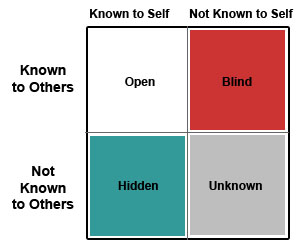Are You Open With Your Marketing Interactions?
The Johari Window is a cognitive psychology tool that was named after its two creators, Joseph Luft and Harry Ingham (“Jo + Hari”). It is used to help people understand their interpersonal relationships. But I’ve found this model to be especially useful for analyzing business interactions between entrepreneurs and their prospects or customers.
Let me show you what I mean…
The Window has four panes (quadrants) that divide your “personal awareness” characteristics into Open, Hidden, Blind, and Unknown. The lines dividing the four panes are like window shades that can move up and down or left and right as an interaction progresses.

The “Open” Quadrant (upper-left)
In the Open quadrant of the Window go things that both you and your customer/prospect know about you.
In an online marketing context, when a new prospect “opts in” to your list, the window shade in this quadrant is practically closed, since there has been little information exchanged between the two of you. But as you build rapport with that prospect by utilizing autoresponder sequences, blog posts, e-letter articles, teleseminars, and other marketing communications, the window shade starts opening and the Open quadrant gets bigger.
The “Blind” Quadrant (upper-right)
In the Blind quadrant go things that your prospect/customer knows about you (on a personal or professional level) that you are unaware of.
Let’s say you’re conducting a teleseminar and one of your callers hangs up in the middle because she has to pick up her kids from school. This information is in your Blind quadrant because she knows she’s hanging up the phone but you don’t.
If that same person calls you after the teleseminar and tells you she had to hang up before the call was over, the window shade in the Blind quadrant starts closing by moving to the right, which enlarges the Open quadrant.
The “Hidden” Quadrant (lower-left)
In the Hidden quadrant go things that you know about yourself or your marketing campaigns (in a business context) that your prospect/customer doesn’t know.
If, for example, you’ve intentionally withheld information about an upcoming marketing launch, this information is in the Hidden quadrant. But as soon as you inform your list about the details of that launch, you pull the window shade down, narrowing the Hidden quadrant and enlarging the Open quadrant.
Here’s the interesting part: As you get to know your prospects and customers better, it’s only natural for you to feel more comfortable about disclosing more intimate details about yourself, right? Well, in a Johari Window context, this process is called: “self-disclosure.” In a marketing context, I call it “transparency.”
Granted, it’s a little scary to be transparent with your prospects and customers the first time. But when you make a habit of it, you’ll discover that it’s the highest impact rapport “accelerator” of all marketing communication methods.
The “Unknown” Quadrant (lower-right)
In the Unknown quadrant are things that neither you nor your prospects/customers know about you or your business.
If you’ve ever done any public speaking, you know how much new information can be revealed to both you and your audience during the course of a typical Q&A session. An interactive situation like this almost always triggers personal growth.
In a Johari Window context, this process moves even more information into the Open quadrant, shrinking the Unknown quadrant. In a marketing context, interacting with your prospects/customers is a “win-win” situation.
So What’s Your Next Step?
Building rapport with your customers/prospects – expanding the Open quadrant of your relationship – is like the game of chess: It’s easy to learn the basics, but it takes a lifetime to master.
But understand this: Once you start communicating with your prospects/customers – especially when you muster up the courage to be increasingly transparent with them – you’ll find that the majority of those relationships will become long-lasting and profitable.
[Ed. Note: Alex Mandossian knows a thing or two about building profitable relationships with customers. He has generated over $233 million in sales for his clients. And in the past three years, he increased his own revenues from $1.5 million to $5 million. You can get Alex’s advice and practical marketing tips for info-publishers, small-business owners, and entrepreneurs for free at alexmandossian.com.]